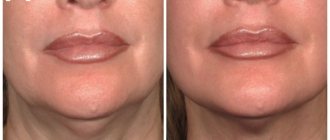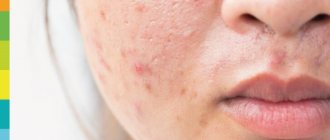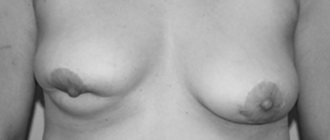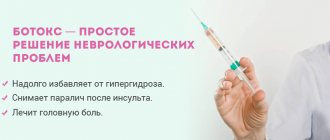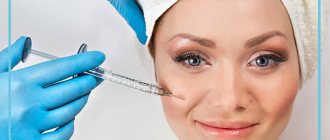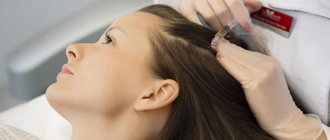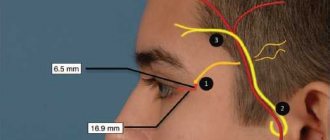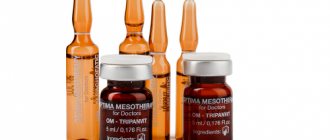Migraine is a pathological condition in which the patient experiences intense, often unbearable headache. The disease is characterized by regular or systematic attacks involving the left or right half of the head. Bilateral or total migraines are rare, but similar clinical cases have been reported in medical practice.
Factors causing migraine
Despite the high intensity of pain during migraine, the pathological condition is not accompanied by brain tumors, strokes and other severe pathologies. According to statistics, up to 15% of the adult population of the planet suffers from migraines.
Factors that theoretically influence the development of pathology are numerous:
- overwork;
- sleep disturbances, lack of sleep;
- stress;
- bad habits;
- traumatic brain injuries suffered during life;
- drinking too much coffee;
- hormonal changes;
- unbalanced diet and so on.
Treatment with botulinum toxin
- Home page
- Treatment
The use of “botulinum toxin type A” injections in modern medicine
The beginning of its experimental use dates back to the 70s of the 20th century.
Since the 80s, botulinum toxin began to be actively used in the United States, and later throughout the world. Currently, weakened and purified botulinum toxin A is used, which in ultra-small doses has a relaxing effect on the muscles.
The mechanism of action of botulinum toxin is to block the transmission of impulses from the nerve ending to the target cell, thereby the cell does not receive a signal to perform any action, which is required to achieve a therapeutic effect. For example: hyperhidrosis of the axillary areas is caused by hyperactivity of the parasympathetic nervous system; when the transmission of impulses from nerve endings to the sweat glands is blocked, there is a significant decrease in the amount of sweat produced, so much so that just a few days ago a problem that seemed unsolvable completely ceases to worry you; facial wrinkles are a consequence of hyperactivity of the facial muscles; Botox injections lead to a decrease in the increased tone of these muscles and, as a result, the disappearance of wrinkles.
Indications for Botox therapy:
Cerebral palsy (CP):
- Spastic and dystonic forms
Focal dystonias:
- Blepharospasm;
- Oro-mandibular dystonia;
- Spasmodic torticollis;
- Laryngeal dystonia (spasmodic dysphonia);
- Dystonia of precise movements (writer's cramp);
- Dystonia of the foot and other dystonic syndromes;
Spasticity:
- due to stroke, traumatic brain injury, multiple sclerosis and other diseases of the brain and spinal cord;
Other manifestations of local muscle hyperactivity:
- Tiki;
- Painful rigidity;
- Hemifacial spasm, contracture of facial muscles;
- Tremor of the head, limbs;
Pain syndromes:
- Myofascial pain syndromes;
- Muscular-tonic syndromes;
- Headaches caused by tension in the pericranial muscles;
- Migraine;
- Painful dysfunction of the temporomandibular joint;
- Painful muscle spasms in the neck, shoulder girdle, back, including post-traumatic and sports (for example, tennis elbow).
Contraindications to the use of Botox therapy
Absolute contraindications:
- Hereditary neuromuscular disorders (myasthenia gravis, Lambert Eaton syndrome, etc.);
- pregnancy;
- lactation;
- local inflammatory process;
- hemophilia and other coagulation disorders;
- hypersensitivity to the components of the drug.
Relative contraindications:
- history of neurological diseases;
- taking anticoagulant drugs (aspirin, etc.);
- somatic diseases in the acute stage;
- the use of drugs that enhance the effect of botulinum toxin: aminoglycoside antibiotics, curare-like muscle relaxants, erythromycin, tetracycline, lincomycin, polymyxin;
- tendency to form keloid and hypertrophic scars;
- It is not recommended to simultaneously introduce gels, silicone, collagen and other contour implants with Botox into the same anatomical areas).
The maximum permissible dose per procedure is 400 units.
| The approximate dosages of botulinum toxin used are as follows: (* The cost of the procedure is determined by the number of units entered) | |
| Name of procedure | Quantity (Unit) |
| Hyperhidrosis of the palms | 150 units (for both hands) |
| Hyperhidrosis of the feet | 150 units (both feet) |
| Hyperhidrosis of the axillary areas | 100 - 120 Units (for both areas) |
| Cosmetology | Up to 50 units |
| Muscular-dystonic disorders | 200 - 300 units |
| Cerebral palsy in children | 20 - 30 units |
| Migraine | Up to 40 units |
The given doses are approximate; their magnitude, as well as the presence of indications and contraindications for treatment, are determined by a neurologist during a face-to-face appointment.
The use of botulinum toxin type A in neurology, 20 years of effective use Seven questions about botulinum therapy
1. How relevant is the use of botulinum toxin type A in neurology?
Indeed, many people mistakenly believe that botulinum therapy is relevant only for aesthetic purposes in cosmetology. This is wrong. Moreover, the first use of botulinum toxin back in 1980 was successfully used to treat concomitant strabismus. Botulinum toxin has been used in the treatment of neurological disorders for more than 20 years and during this time it has proven itself to be an effective and safe remedy in practice.
2. For what diseases or conditions do you recommend injections of botulinum toxin type A?
There are officially registered indications for treatment with botulinum toxin type A:
Blepharospasm, cervical dystonia (spasmodic torticollis), spasticity of the upper and lower extremities (including: contractures after stroke, cerebral palsy), correction of facial wrinkles, hyperhidrosis or increased sweating (axillary region, symptom of wet palms, feet).
In addition to its registered indications for use, botulinum toxin is also used in other areas of medicine (treatment of urinary incontinence, vocal cord dystonia), as well as movement disorders caused by multiple sclerosis, Parkinson's disease or traumatic brain injury.
3. How dangerous is botulinum toxin to the body?
Botulinum toxin is used today in more than 60 countries around the world. The registration of this medicine was preceded by numerous clinical trials that confirmed its effectiveness and safety. In terms of human health consequences, botulinum toxin injections are much less harmful than most pills. Reactions to botulinum toxin are transient and local, and tablets used for similar indications have a negative effect on the liver and kidneys. The practice of botulinum therapy has existed for decades. During this time, millions of people around the world received treatment. This is enough for not only immediate but also delayed consequences to become known. These have not been identified to this day. Therefore, we can say with confidence that of all the drugs used to treat dystonia and spasticity, botulinum toxin preparations implement the main principle - do no harm to the patient.
4. How quickly does the effect occur after botulinum toxin injection?
Depending on the disease, the effect begins to appear within 2-3 days after administration and reaches its peak after 7-12 days.
5. How long does the effect last?
From 4 months to a year. It is important that satisfaction with the result is noted in more than 90% of patients.
6. Therapy associated with the use of botulinum toxin drugs is considered expensive and inaccessible. How fair is this opinion?
All modern effective drugs are not cheap. The costs of development, production, and clinical trials are high, and this cannot but affect the price. However, despite this, there are many European studies that have proven that treatment with botulinum toxin type A turned out to be more economical than treatment with oral medications in terms of “cost of effective treatment per month” and “improving the patient’s quality of life in general. Remember - only health is more valuable.
7. Why is botulinum toxin the optimal solution?
On the one hand, in terms of the force of action on the muscle, botulinum toxin is significantly superior to all existing antispastic drugs used in the form of tablets, and is comparable in effectiveness to surgical intervention.
On the other hand, muscle denervation using a toxin is an extremely simple and safe procedure that can be performed by a neurologist.
Thus, the use of botulinum toxin can be considered a reasonable compromise between effectiveness and safety. It is characterized by very good tolerability, almost eliminating the possibility of drug-drug interactions.
More detailed advice for patients and their relatives can be obtained during an appointment with neurologist Konstantin Valerievich Vinogradov
BE HEALTHY!
You can make an appointment with a neurologist by calling:
+7,
or order a call back using the electronic form on the website: clinicamz.ru
The administrator will contact you to clarify and confirm your appointment. The World of Health Clinic guarantees complete confidentiality of your request.
At the World of Health clinic, a neurologist, a specialist in botulinum therapy, conducts consultations:
Vinogradov Konstantin Valerievich - neurologist, specialist in botulinum therapy
The main reason for the development of the disease
One of the main causes of pathology is considered to be compression of the trigeminal nerve or its branches. According to studies conducted in the USA, Germany and Austria, in 57% of subjects, the mechanism of migraine development was associated with the interaction of the trigeminal nerve and the contraction of the corrugator muscle located in the brow ridge.
This muscular structure of the face is responsible for wrinkling the skin above and between the eyebrows and is also called the “frown line.” One of the sections of the trigeminal nerve is associated with this muscular structure of the face. When a person, making facial movements, causes a muscle to move, the trigeminal nerve is irritated, and an attack occurs.
These studies confirm that the development of migraines is associated with the emotional state of patients. Experiencing anger, surprise, irritation and other emotions in which the muscle of the superciliary region is involved in the action, the process of migraine starts.
Effect of the drug after administration
A migraine attack occurs when blood vessels dilate. They pass in the neck and head. Botulinum toxin is a paralyzing agent. It affects muscle tissue. This substance is considered one of the most dangerous poisons in the world. To obtain the desired result, a small amount is used and other components are included in the composition.
The use of the drug leads to the fact that the muscles are in an inactive state. He doesn't let them shrink. Botox has an indirect effect on the walls of the vessel, keeping them in one state. Other features:
- The toxin acts on transport proteins. They are responsible for the formation of nerve impulses.
- When proteins are blocked, cholinergic receptors do not work, so muscle contraction does not occur.
Botox is used in cosmetology due to its ability to smooth out wrinkles. However, the paralyzing effect can also reduce the manifestation of migraine symptoms.
At the time of symptoms, the pain intensifies due to spasms that occur in the muscles of the skull and neck. This leads not only to pain, but also to chronic fatigue and an increase in general overstrain.
Preparation for surgical treatment
Before proceeding with the operation, the doctor determines the need for it. Migraines are similar in etiology and clinical signs to ordinary headaches. To make a diagnosis, a differential analysis is performed to determine whether the patient actually suffers from migraines.
To make a diagnosis, the patient fills out a questionnaire in which he answers the following questions:
- family medical history;
- description of clinical signs of the disease, nature of pain, features of their manifestation;
- listing a list of possible pathogens and triggers of the disease;
- number of attacks during the day, week, month, year (parameters are individual);
- information about previous treatment and medications used.
Based on data obtained from a questionnaire, as well as personal communication with a doctor, the doctor determines the fact of migraine development and determines the form of the disease.
Botulinum toxin is the best remedy for migraines
At the Dial-Dent clinic, botulinum toxin injections for the treatment of migraines are performed by experienced cosmetologists.
Migraine treatment with Botox is indicated for those who experience constant headaches, but cannot use traditional painkillers due to intolerance or addiction. Patients often find themselves in a vicious circle of being forced to take pain medications that have serious side effects and can cause additional pain. For most patients, prescribed migraine medications do not help at all! Botulinum toxin type A has virtually no side effects. There are also practically no contraindications to the use of botulinum toxin injections; they are standard: age under 18 years, pregnancy, lactation, systemic blood diseases. The treatment plan is drawn up individually; of course, before starting treatment, consultation with a specialist is necessary.”
Read about other possibilities of the aesthetic cosmetology department of the Dial-Dent clinic here.
Make an appointment by phone +7-499-110-18-02 or through the form on the website. You can ask questions about the work of the cosmetology department to the chief physician of the clinic, Sergei Vladimirovich Tsukor, at
Botulinum toxin test
This test helps determine whether a patient will benefit from surgery to treat their migraines. The test recreates the effect of surgery using Botox.
The mechanism of the test involves the injection of botulinum toxin into selected points of the branches of the tertiary nerve:
- in the eyebrow area;
- temporal area;
- upper neck;
- nose.
Under the influence of Botox, selected muscle structures are paralyzed. The procedure helps to relax the muscle structures involved in the chain of irritation of the tertiary nerve. The effect of Botox injection lasts for 2-4 months, all this time the patient keeps a diary, recording each attack and his feelings in general
Provided pain relief and a decrease in the frequency of attacks, the test is considered successful. This fact is the reason for carrying out a full-fledged surgical intervention.
"Pain Diary" and side effects
An important part of the therapy is keeping a so-called pain diary, in which the patient notes the days with migraine and monitors progress. The diary allows you to determine how often injections need to be given, the agency’s interlocutor explained. On average, they are done once every 12 weeks, but for each patient the doctor selects the frequency based on the “pain diary”.
Stang considers Botox a better choice because, unlike drugs commonly used for migraines, it has no side effects.
“Two drugs have an evidence base - [these] topiramate and amitriptyline, in addition to botulinum toxin type A. Usually the doctor discusses with the patient how he will be helped. But there are overweight patients, there are patients who need to engage in intellectual work, and these drugs have their side effects,” the doctor said. Thus, topiramate can lead to a decrease in cognitive function, and amitriptyline promotes weight gain.
At the same time, Stang warned, Botox injections cannot completely cure migraines - they cannot be treated in principle. They can only help alleviate attacks and make them less frequent.
Technique of the operation
If the botulinum toxin test is successful, this is considered a reason for surgery. The surgical technique for treating migraines is as follows:
- The surgeon makes a small incision in the area where botulinum toxin was previously applied.
- Through an incision made in the skin, the doctor gains access to the muscle structures involved in irritating the tertiary nerve during their contractile activity.
- The surgeon excises the muscle that initiates the attacks of pain.
- During the excision of muscle fibers, the nerve endings located in the surgical area are not affected or damaged.
- After removing the muscle fibers that provoke the attack, the incision is sutured and the operation is completed.
The meaning of the surgical intervention is simple - the removed muscle “falls out” of the contractile chain, which previously irritated the nerve endings associated with the trigeminal nerve. As a result, a person is freed from migraine attacks. You can undergo surgical treatment after a successful botulinum toxin test in Switzerland.
Migraine treatment - botulinum toxin injections
Initially, injections of botulinum toxin type A (BTA) were not used to treat migraines, but were used in cosmetology. But many patients with a history of chronic headaches noted a positive side effect of botulinum toxin therapy - migraine attacks became easier and/or recurred less frequently. Next, “PREEMPT 1” and “PREEMPT 2” were carried out. Experts conducted two double trials on the effect of botulinum toxin on chronic migraine. In the trials, some patients received botulinum toxin injections, and some received a placebo (dummy). At the same time, the study participants did not know what exactly the patients were receiving in order to exclude psychological influence on the results.
The result of the research was the recognition of botulinum toxin as an effective drug for the treatment of chronic migraine. It has been used successfully to prevent headaches in adult patients with chronic migraine (more than 15 days per month with headache lasting 4 hours per day or longer). The effectiveness of botulinum toxin injections has not been established in patients with episodic migraine (several headaches per month). Botulinum toxin injections for the treatment of migraine are performed according to a specially developed protocol. The therapeutic effect of using botulinum toxin lasts more than 3 months.
Benefits of surgical treatment
Surgical surgery for migraine is performed only if the botulinum toxin test is positive. In this case, it is possible to predict the success of treatment, which has a number of tangible advantages:
- subject to successful treatment, the need to constantly use medications to alleviate the intensity of migraine attacks or reduce their frequency disappears;
- the effect of removing muscle structures that act as an irritant to the tertiary nerve lasts a long time;
- if a surgeon removes muscle structures in the eyebrow area, facial activity in this area of the face decreases, and at the same time the likelihood of facial wrinkles appearing;
- surgical intervention is classified as minimally invasive, accompanied by minimal tissue trauma and a short rehabilitation period.
What does the program provide?
You will have an individual calendar for visiting your doctor for migraines. If you have an acute migraine attack, our doctors will help you stop it in a short-term hospital stay (up to two hours).
You do not have to pay for each visit to the clinic separately: the program includes a consultation with specialist Myasnikov N.B. (up to five visits a month for the first four months, then up to four and two), assistance during an acute attack of migraine with a hospital stay or intensive care unit (up to five times a month), administration of the drugs Perfalgan and Irinex, as well as information support.
How to get involved
To become a participant in the program, you will need:
- Head MRI examination data
- Consultation with the chief physician of GMS Hospital Myasnikov N.B.
In the future, the doctor will monitor the treatment and monitor your health.
We guarantee care, attention and individual treatment to each program participant. GMS Clinic offers high quality service and expert level medicine. Doctors at our clinic are constantly learning new things: taking advanced training courses and participating in foreign internships.
The program is designed for 6 months and the cost is indicated for the entire duration of the program. The call center or reception staff will tell you more about the program.
